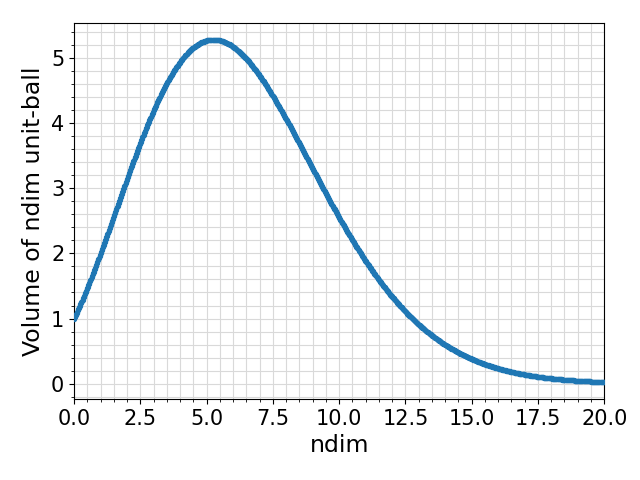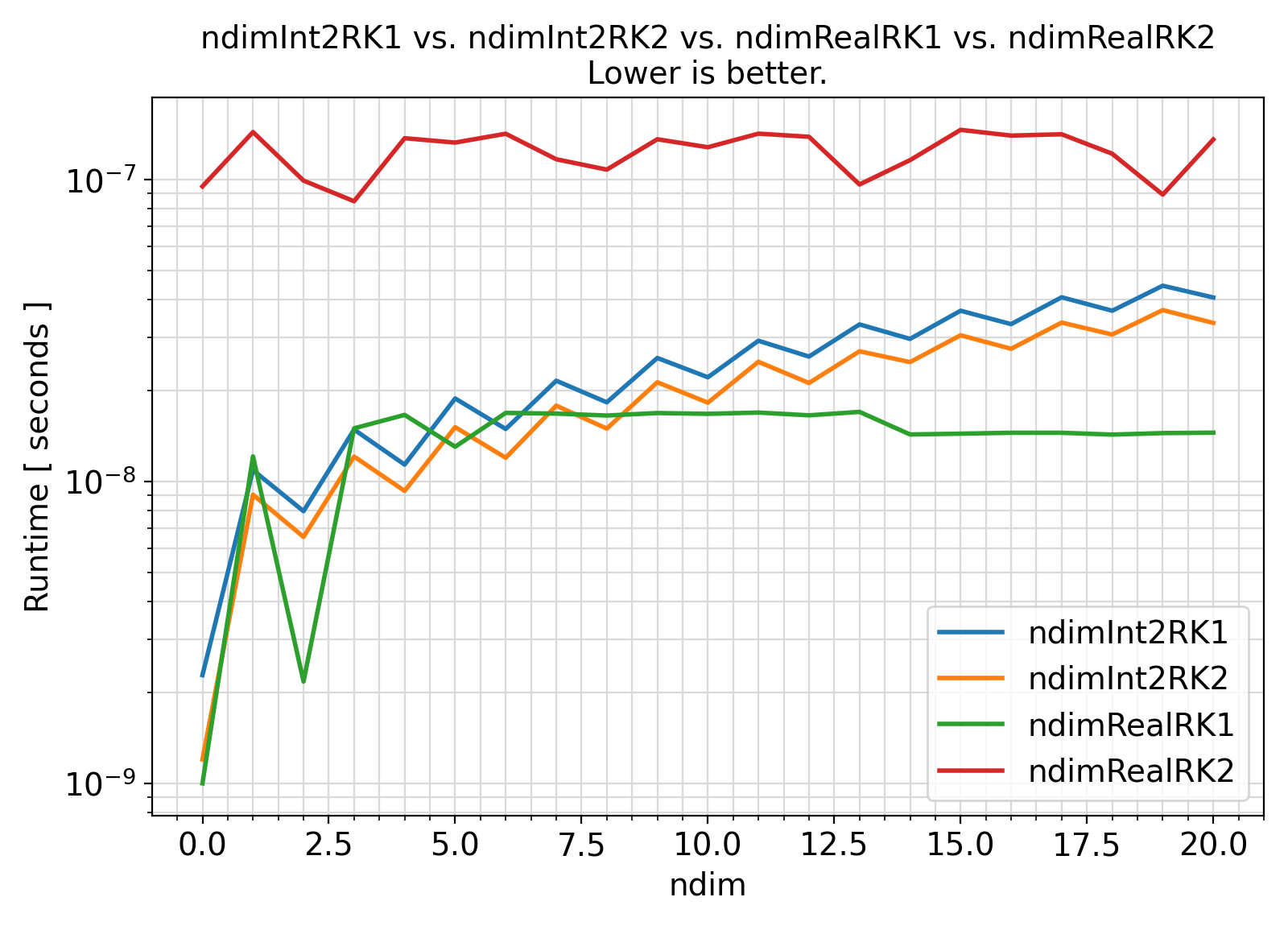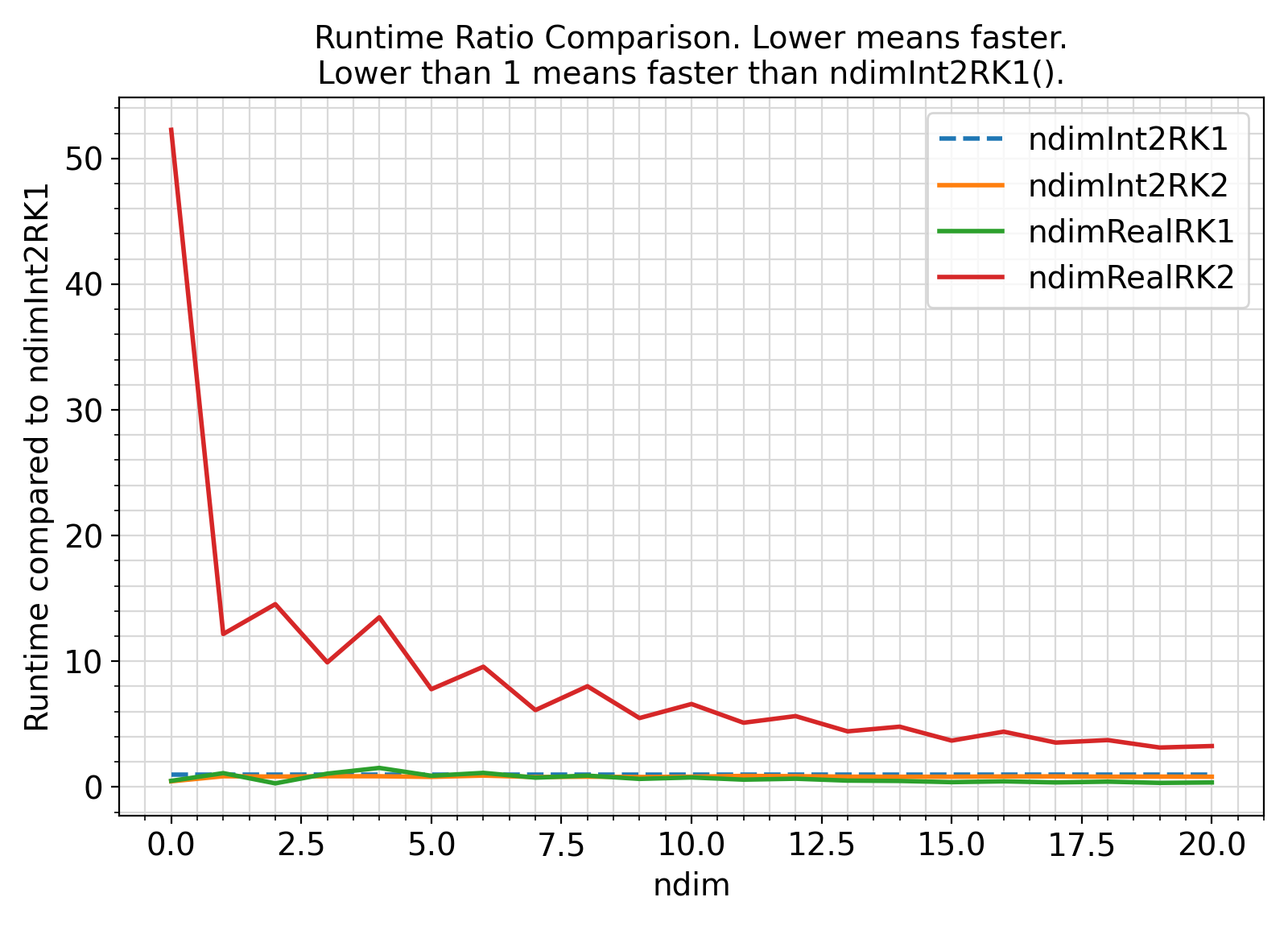Return the natural logarithm of the volume of an \ndim-dimensional ball of unit-radius.
The computation of the volume of an n-ball requires involves factorials which are computed in the procedures of this generic interface via the Fortran intrinsic log_gamma().
This generic subroutine interface is an exact functional-interface replacement for the generic functional interface getLogVolUnitBall.
- Parameters
-
| [out] | logVolUnitBall | : The output scalar (or array of the same rank as other input array-like arguments) of,
-
type
real of kind any supported by the processor (e.g., RK, RK32, RK64, or RK128),
containing natural logarithm of the volume of the unit-radius hyper-ball.
|
| [in] | ndim | : The input scalar containing the number of dimensions of the unit-radius hyper-ball.
It can be,
-
of type
integer of default kind IK, in which case the output will be computed using an iterative factorial algorithm, or
-
of the same type and kind as the output
logVolUnitBall, in which case the output will be computed using the Fortran intrinsic log_gamma().
|
Possible calling interfaces ⛓
Return the natural logarithm of the volume of an -dimensional ball of unit-radius.
This module contains classes and procedures for setting up and computing the properties of the hyper-...
- Warning
- The condition
0 <= ndim must hold for the corresponding input arguments.
This condition is verified only if the library is built with the preprocessor macro CHECK_ENABLED=1.
-
The
pure procedure(s) documented herein become impure when the ParaMonte library is compiled with preprocessor macro CHECK_ENABLED=1.
By default, these procedures are pure in release build and impure in debug and testing builds.
- See also
- getLogVolUnitBall
Volume of an n-ball
Particular values of the Gamma function
Example usage ⛓
9 real(RKG) :: logVolUnitBall(
5)
11 type(display_type) :: disp
15 call disp%show(
"call setLogVolUnitBall(logVolUnitBall(1), ndim = 2_IK)")
22 call disp%show(
"call setLogVolUnitBall(logVolUnitBall(1), ndim = 2._RKG)")
29 call disp%show(
"call setLogVolUnitBall(logVolUnitBall(1:5), ndim = [integer(IK) :: 0, 1, 2, 3, 4])")
30 call setLogVolUnitBall(logVolUnitBall(
1:
5), ndim
= [
integer(IK) ::
0,
1,
2,
3,
4])
31 call disp%show(
"logVolUnitBall(1:5)")
32 call disp%show( logVolUnitBall(
1:
5) )
36 call disp%show(
"call setLogVolUnitBall(logVolUnitBall(1:5), ndim = [real(RKG) :: 0, 1, 2, 3, 4.5])")
37 call setLogVolUnitBall(logVolUnitBall(
1:
5), ndim
= [
real(RKG) ::
0,
1,
2,
3,
4.5])
38 call disp%show(
"logVolUnitBall(1:5)")
39 call disp%show( logVolUnitBall(
1:
5) )
48 integer(IK),
parameter :: nsim
= 1000_IK
49 integer(IK) :: fileUnit, i
50 real :: volUnitBall(nsim), ndim(nsim)
51 open(newunit
= fileUnit, file
= "setLogVolUnitBall.RK.txt")
55 write(fileUnit,
"(*(g0,:,','))") ndim(i),
exp(volUnitBall(i))
Return the linSpace output argument with size(linSpace) elements of evenly-spaced values over the int...
This is a generic method of the derived type display_type with pass attribute.
This is a generic method of the derived type display_type with pass attribute.
This module contains procedures and generic interfaces for generating arrays with linear or logarithm...
This module contains classes and procedures for input/output (IO) or generic display operations on st...
type(display_type) disp
This is a scalar module variable an object of type display_type for general display.
This module defines the relevant Fortran kind type-parameters frequently used in the ParaMonte librar...
integer, parameter LK
The default logical kind in the ParaMonte library: kind(.true.) in Fortran, kind(....
integer, parameter IK
The default integer kind in the ParaMonte library: int32 in Fortran, c_int32_t in C-Fortran Interoper...
integer, parameter SK
The default character kind in the ParaMonte library: kind("a") in Fortran, c_char in C-Fortran Intero...
integer, parameter RKH
The scalar integer constant of intrinsic default kind, representing the highest-precision real kind t...
Generate and return an object of type display_type.
Example Unix compile command via Intel ifort compiler ⛓
3ifort -fpp -standard-semantics -O3 -Wl,-rpath,../../../lib -I../../../inc main.F90 ../../../lib/libparamonte* -o main.exe
Example Windows Batch compile command via Intel ifort compiler ⛓
2set PATH=..\..\..\lib;%PATH%
3ifort /fpp /standard-semantics /O3 /I:..\..\..\include main.F90 ..\..\..\lib\libparamonte*.lib /exe:main.exe
Example Unix / MinGW compile command via GNU gfortran compiler ⛓
3gfortran -cpp -ffree-line-length-none -O3 -Wl,-rpath,../../../lib -I../../../inc main.F90 ../../../lib/libparamonte* -o main.exe
Example output ⛓
4+1.14472988584940017414342735135305866
9+1.14472988584940017414342735135305866
14+0.00000000000000000000000000000000000,
+0.693147180559945309417232121458176575,
+1.14472988584940017414342735135305866,
+1.43241195830118110158264635734688620,
+1.59631259113885503886962258124794093
19+0.00000000000000000000000000000000000,
+0.693147180559945309417232121458176575,
+1.14472988584940017414342735135305866,
+1.43241195830118110158264635734688600,
+1.63984031205242503356424402200248520
Postprocessing of the example output ⛓
3import matplotlib.pyplot
as plt
14 pattern =
"*." + kind +
".txt"
15 fileList = glob.glob(pattern)
19 df = pd.read_csv(file, delimiter =
",", header =
None)
29 plt.rcParams.update({
'font.size': fontsize - 2})
45 for i
in range(0, len(df.values[0,:]), 2):
46 ax.scatter ( df.values[:,i]
56 ax.set_xlim([0, df.values[-1,:].max()])
57 ax.set_xlabel(
"ndim", fontsize = 17)
58 ax.set_ylabel(
"Volume of ndim unit-ball", fontsize = 17)
59 plt.grid(visible =
True, which =
"both", axis =
"both", color =
"0.85", linestyle =
"-")
63 plt.savefig(file.replace(
".txt",
".png"))
Visualization of the example output ⛓
- Benchmarks:
Benchmark :: The runtime performance of setLogVolUnitBall for integer vs. real input ndim. ⛓
7 use iso_fortran_env,
only:
error_unit
13 integer(IK) :: fileUnit
14 integer(IK) :: ndim_IK
16 real(RK1) :: logVolUnitBall_RK1
17 real(RK1) :: dum_RK1
= 0._RK1
20 real(RK2) :: logVolUnitBall_RK2
21 real(RK2) :: dum_RK2
= 0._RK2
23 type(bench_type) ,
allocatable :: bench(:)
25 bench
= [
bench_type(name
= SK_
"ndimInt2RK1", exec
= ndimInt2RK1, overhead
= setOverhead_RK1)
&
26 ,
bench_type(name
= SK_
"ndimInt2RK2", exec
= ndimInt2RK2, overhead
= setOverhead_RK1)
&
27 ,
bench_type(name
= SK_
"ndimRealRK1", exec
= ndimRealRK1, overhead
= setOverhead_RK1)
&
28 ,
bench_type(name
= SK_
"ndimRealRK2", exec
= ndimRealRK2, overhead
= setOverhead_RK2)
&
31 write(
*,
"(*(g0,:,' '))")
32 write(
*,
"(*(g0,:,' '))")
"setLogVolUnitBallInt() vs. setLogVolUnitBallReal()"
33 write(
*,
"(*(g0,:,' '))")
35 open(newunit
= fileUnit, file
= "main.out", status
= "replace")
37 write(fileUnit,
"(*(g0,:,','))")
"ndim", (bench(i)
%name, i
= 1,
size(bench))
38 loopOverArraySize:
do idim
= 0,
20_IK
41 ndim_RK1
= real(idim,
RK1)
42 ndim_RK2
= real(idim,
RK2)
43 write(
*,
"(*(g0,:,' '))")
"Benchmarking with ndim = ", idim
45 bench(i)
%timing
= bench(i)
%getTiming(minsec
= 0.04_RK)
47 write(fileUnit,
"(*(g0,:,','))") idim, (bench(i)
%timing
%mean, i
= 1,
size(bench))
49 end do loopOverArraySize
50 write(
*,
"(*(g0,:,' '))") dum_RK1
51 write(
*,
"(*(g0,:,' '))")
61 subroutine setOverhead_RK1()
65 subroutine setOverhead_RK2()
69 subroutine getDummy_RK1()
70 dum_RK1
= dum_RK1
+ logVolUnitBall_RK1
73 subroutine getDummy_RK2()
74 dum_RK2
= dum_RK2
+ logVolUnitBall_RK2
77 subroutine ndimInt2RK1()
83 subroutine ndimInt2RK2()
89 subroutine ndimRealRK1()
95 subroutine ndimRealRK2()
Generate count evenly spaced points over the interval [x1, x2] if x1 < x2, or [x2,...
Generate and return an object of type timing_type containing the benchmark timing information and sta...
This module contains abstract interfaces and types that facilitate benchmarking of different procedur...
integer, parameter RK
The default real kind in the ParaMonte library: real64 in Fortran, c_double in C-Fortran Interoperati...
integer, parameter RKD
The double precision real kind in Fortran mode. On most platforms, this is an 64-bit real kind.
integer, parameter RKS
The single-precision real kind in Fortran mode. On most platforms, this is an 32-bit real kind.
This is the class for creating benchmark and performance-profiling objects.
Example Unix compile command via Intel ifort compiler ⛓
3ifort -fpp -standard-semantics -O3 -Wl,-rpath,../../../lib -I../../../inc main.F90 ../../../lib/libparamonte* -o main.exe
Example Windows Batch compile command via Intel ifort compiler ⛓
2set PATH=..\..\..\lib;%PATH%
3ifort /fpp /standard-semantics /O3 /I:..\..\..\include main.F90 ..\..\..\lib\libparamonte*.lib /exe:main.exe
Example Unix / MinGW compile command via GNU gfortran compiler ⛓
3gfortran -cpp -ffree-line-length-none -O3 -Wl,-rpath,../../../lib -I../../../inc main.F90 ../../../lib/libparamonte* -o main.exe
Postprocessing of the benchmark output ⛓
3import matplotlib.pyplot
as plt
8dirname = os.path.basename(os.getcwd())
12df = pd.read_csv(
"main.out", delimiter =
",")
13colnames = list(df.columns.values)
19ax = plt.figure(figsize = 1.25 * np.array([6.4,4.6]), dpi = 200)
22for colname
in colnames[1:]:
23 plt.plot( df[colnames[0]].values
28plt.xticks(fontsize = fontsize)
29plt.yticks(fontsize = fontsize)
30ax.set_xlabel(colnames[0], fontsize = fontsize)
31ax.set_ylabel(
"Runtime [ seconds ]", fontsize = fontsize)
32ax.set_title(
" vs. ".join(colnames[1:])+
"\nLower is better.", fontsize = fontsize)
36plt.grid(visible =
True, which =
"both", axis =
"both", color =
"0.85", linestyle =
"-")
37ax.tick_params(axis =
"y", which =
"minor")
38ax.tick_params(axis =
"x", which =
"minor")
39ax.legend ( colnames[1:]
46plt.savefig(
"benchmark." + dirname +
".runtime.png")
52ax = plt.figure(figsize = 1.25 * np.array([6.4,4.6]), dpi = 200)
55plt.plot( df[colnames[0]].values
56 , np.ones(len(df[colnames[0]].values))
61for colname
in colnames[2:]:
62 plt.plot( df[colnames[0]].values
63 , df[colname].values / df[colnames[1]].values
67plt.xticks(fontsize = fontsize)
68plt.yticks(fontsize = fontsize)
69ax.set_xlabel(colnames[0], fontsize = fontsize)
70ax.set_ylabel(
"Runtime compared to {}".format(colnames[1]), fontsize = fontsize)
71ax.set_title(
"Runtime Ratio Comparison. Lower means faster.\nLower than 1 means faster than {}().".format(colnames[1]), fontsize = fontsize)
75plt.grid(visible =
True, which =
"both", axis =
"both", color =
"0.85", linestyle =
"-")
76ax.tick_params(axis =
"y", which =
"minor")
77ax.tick_params(axis =
"x", which =
"minor")
78ax.legend ( colnames[1:]
85plt.savefig(
"benchmark." + dirname +
".runtime.ratio.png")
Visualization of the benchmark output ⛓
Benchmark moral ⛓
- The benchmark procedures named
ndimInt2RK1 and ndimInt2RK2 call the generic interface setLogVolUnitBall with a ndim argument of type integer of kind IK and return the result as real of kind RKS and RKD respectively.
Conversely, the procedures named ndimReal2RK1 and ndimReal2RK2 take ndim as real of kind RKS and RKD respectively and return results of the same type and kind as ndim.
The first class of procedure interfaces (working with a ndim of type integer) compute the result using an iterative factorial computation approach.
The second class of procedure interfaces (working with a ndim of type real) use the Fortran intrinsic log_gamma() to compute the results.
This performance difference tends to be about a factor of 10 times for scalar optional arguments and grows substantially to larger factors with switching to increasing-size array-like optional dummy arguments.
- From the benchmark results it appears that the interface accepting
ndim of type RK32 offers the fastest algorithm, followed by the iterative methods.
- Test:
- test_pm_ellipsoid
Final Remarks ⛓
If you believe this algorithm or its documentation can be improved, we appreciate your contribution and help to edit this page's documentation and source file on GitHub.
For details on the naming abbreviations, see this page.
For details on the naming conventions, see this page.
This software is distributed under the MIT license with additional terms outlined below.
-
If you use any parts or concepts from this library to any extent, please acknowledge the usage by citing the relevant publications of the ParaMonte library.
-
If you regenerate any parts/ideas from this library in a programming environment other than those currently supported by this ParaMonte library (i.e., other than C, C++, Fortran, MATLAB, Python, R), please also ask the end users to cite this original ParaMonte library.
This software is available to the public under a highly permissive license.
Help us justify its continued development and maintenance by acknowledging its benefit to society, distributing it, and contributing to it.
- Copyright
- Computational Data Science Lab
- Author:
- Amir Shahmoradi, April 23, 2017, 1:36 AM, Institute for Computational Engineering and Sciences (ICES), University of Texas at Austin
Definition at line 558 of file pm_ellipsoid.F90.




